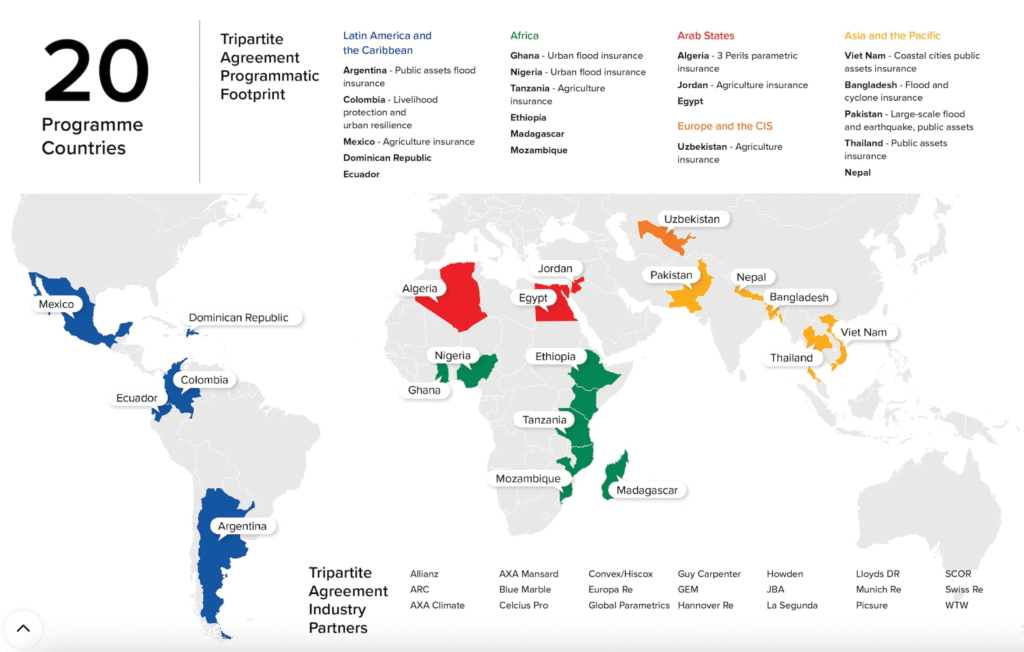This article originally appeared in Impact Entrepreneur Magazine, written by Gigi Aulsebrook, published on 28th June 2025. Accessible via the following link: https://impactentrepreneur.com/why-insurers-must-step-up-for-climate-vulnerable-industries/
Time to close the gap
In a world where disasters are the new normal, insurance must become faster, fairer, and more accessible, especially to those communities who are adversely at risk.
In a world facing escalating climate disasters, the need for effective risk protection is more urgent than ever. Yet, in many regions, especially in the Global South, insurance systems remain underdeveloped or inaccessible. When disasters hit – whether it be a flood, wildfire, or drought – affected communities are often left without the necessary coverage or financial safety net to recover and rebuild.
At ChangeNOW in Paris, recent discussions with experts from UNDP IRFF, IFRC, AXA Climate and others revealed a staggering reality: $320 billion in damages and $520 billion (quoting the World Bank – and this number is exercising caution) when factoring in human costs. Yet, the insurance industry’s response has been slow, and access to coverage remains limited. This gap isn’t just a matter of capacity, it is a matter of willingness and innovation. With $44 trillion in global assets managed by insurers, even a small shift toward climate risk management could make a monumental difference, and it’s a good market opportunity. But this shift needs to happen faster and more broadly.

The growing divide
It is impossible to ignore the stark inequality in the global insurance system. Vulnerable sectors, like agriculture (in particular), are being hit hardest by climate change, and insurance solutions are either too expensive or non-existent. Farmers in low-income countries, for example, often find themselves unable to afford coverage when extreme weather events threaten their livelihoods. Meanwhile, industries in the wealthiest countries benefit from subsidies and government-backed safety nets. This creates a cycle where the most vulnerable are left unprotected, while the wealthiest continue to access the resources to recover quickly and are better suited to compete.
Countries like Uzbekistan, which once had no insurance infrastructure, have begun to build it from scratch through strategic partnerships. But the real question is: Is the global insurance industry ready to scale these efforts to meet the needs of the most vulnerable?
The call for data transparency and access
For insurers to step up, one fundamental barrier must be addressed: the lack of access to accurate, real-time data in vulnerable regions. Communities in the Global South often lack the tools and systems to assess their risks, resulting in their inability to participate in or benefit from insurance markets. This is where data transparency becomes critical. By pushing for open, accessible data systems, insurers can enable local actors – like farmers, small business owners, and governments – to make informed decisions and access coverage that meets their unique needs.
Data-driven solutions could also help insurers develop tailored, localized products that are affordable and effective. In doing so, insurers would not only help mitigate risk, but also increase participation in the market, empowering communities to protect themselves against climate impacts.

The private sector’s role
But the role of the private sector doesn’t stop at insurance. Fintech firms, reinsurance companies, and tech innovators can all play an integral part in building resilience. For example, fintech platforms could create digital insurance solutions that reach smallholders or communities with limited access to traditional banking. Reinsurance companies can back local insurers, providing them with the financial muscle to expand coverage. And technology companies can bring new tools, like AI and machine learning, to help model risk and predict disaster impacts more accurately.
These sectors can develop holistic solutions that not only provide coverage but also drive resilience-building efforts in high-risk regions, only if they work and collaborate together. And if successful, has the potential to close the gap in climate insurance and provide much-needed protection.
Insurance as a tool for prevention, not just payouts
Insurance has traditionally been a reactive tool, not always there before a disaster happens. To truly protect vulnerable communities, insurance needs to shift from a post-disaster payout model to one that rewards proactive risk management. Insurers can offer incentives for farmers or businesses that invest in disaster-preparedness measures, such as building flood defences or switching to drought-resistant crops. This supports the reduction in the frequency and severity of the claims, which in turn reduces the costs for every part involved.
This isn’t just about protecting assets, it’s about building resilience before the next disaster strikes. Insurers should partner with local communities, NGOs, and governments to encourage and fund these proactive measures, which will ultimately save lives, property, and economies in the long run.
Examples of success
While the challenges are immense, there are already examples of success that show insuring fragile contexts can work, and that change is actually possible. In Uzbekistan, for instance, UNDP worked alongside the government to establish a local insurance system where one had never existed. As a result, tailored solutions were created that addressed the country’s unique climate risks.
Similarly, micro-insurance models in countries like Kenya have begun to show real promise. In Kenya, mobile-based insurance platforms have helped smallholder farmers gain coverage against climate risks, offering affordable policies that make a tangible difference in their ability to recover after disasters.
Another promising example is the Disaster Response Emergency Fund (DREF) insurance mechanism led by the IFRC. This approach allows for the rapid release of funds in response to emergencies, particularly in fragile contexts where delays can cost lives. It combined pre-arranged financing with local preparedness to allow for timely and effective support before crises escalate to the communities most in need. IFRC-DREF Insurance was developed in partnership with Aon and the Centre for Disaster Protection.

Proactive risk reduction: Shifting the focus from recovery to prevention
However, insurance must do more than just respond by actively promoting proactive risk reduction. By integrating disaster risk reduction strategies into insurance policies, insurers can help communities prevent disasters before they happen. For example, offering lower premiums to farmers who implement flood-prevention measures or incentivizing communities to build resilient infrastructure can reduce both the risk and the cost of disaster. Insurance, when done right, can be a tool not just for recovery, but for resilience-building. And by shifting the focus to prevention, insurers can reduce the need for costly payouts, ultimately benefiting everyone involved.
Financial mechanisms beyond insurance
Insurance alone isn’t enough to address the full scale of the climate crisis. To truly protect vulnerable communities, insurers need to collaborate with governments, multilaterals, and other sectors to develop a wider range of financial tools. Catastrophe bonds, climate resilience funds, and disaster recovery bonds are just a few examples of alternative financial mechanisms that could provide immediate access to capital for recovery and preparedness. These products can complement insurance coverage by offering quick, flexible financial support when it’s most needed. Ensuring a diversified portfolio of financial products and tools allows for a more comprehensive safety net that covers all aspects of disaster risk, from both preparedness to recovery.
The time to act is now
The climate crisis is not a distant threat, it is very much here. Vulnerable communities are already suffering, and the gap in insurance access is widening. But the solution is within reach. Governments, insurers, and the private sector must work together to create inclusive, proactive, and transparent insurance systems that can protect everyone, not just those who can afford it — i.e. the wealthy few.
The insurance industry has a pivotal role to play in building climate resilience. But to do so, it must go beyond traditional models and embrace innovation, collaboration, and a focus on prevention – especially in regions most adversely affected by the impacts of the climate crisis. The risks are no longer hypothetical. The real question is whether we, collectively, will have the conviction and coordination to respond with the urgency this moment demands.



